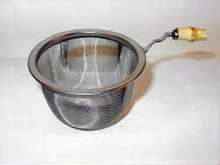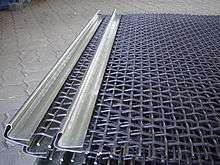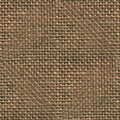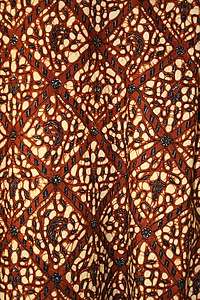Mesh
A mesh is a barrier made of connected strands of metal, fiber, or other flexible or ductile materials. A mesh is similar to a web or a net in that it has many attached or woven strands.

A tea strainer made of metal mesh

Metal screen mesh
Types
- A plastic mesh may be extruded, oriented, expanded, woven[1] or tubular. It can be made from polypropylene, polyethylene, nylon, PVC or PTFE.
- A metal mesh may be woven, knitted, welded, expanded, photo-chemically etched or electroformed (screen filter) from steel or other metals.
- In clothing, mesh is loosely woven or knitted fabric that has many closely spaced holes. Knitted mesh is frequently used for modern sports jerseys and other clothing like hosiery and lingerie
- A mesh skin graft is a skin patch that has been cut systematically to create a mesh. Meshing of skin grafts provides coverage of a greater surface area at the recipient site, and also allows for the egress of serous or sanguinous fluid. However, it results in a rather pebbled appearance upon healing that may ultimately look less aesthetically pleasing.[2]
- Fiberglass mesh[3] is a neatly woven, crisscross pattern of fiberglass thread that can be used to create new products such as door screens, filtration components, and reinforced adhesive tapes. It is commonly sprayed with a PVC coating to make it stronger, last longer, and to prevent skin irritation.
- Coiled wire fabric is a type of mesh that is constructed by interlocking metal wire coils via a simple corkscrew method. The resulting spirals are then woven together to create a flexible metal fabric panel. Coiled wire fabric mesh is a product that is used by architects to design commercial and residential structures. It is also used in industrial settings to protect personnel and contain debris. Additionally, coiled wire fabric mesh is used for zoo enclosures, typically aviary and small mammal exhibits. [4]
Uses
- Meshes are often used to screen out insects. Wire screens on windows and mosquito netting are meshes.
- Wire screens can be used to shield against radio frequency radiation, e.g. in microwave ovens and Faraday cages.
- Metal and nylon wire mesh filters are used in filtration.
- Wire mesh is used in guarding for secure areas and as protection in the form of vandal screens.
- Wire mesh can be fabricated to produce park benches, waste baskets and other baskets for material handling.
- Woven meshes are basic to screen printing.
- Surgical mesh is used to provide a reinforcing structure in surgical procedures like inguinal hernioplasty, and umbilical hernia repair.
- Meshes are used as drum heads in practice and electronic drum sets.
- Fence for livestock or poultry (chicken wire or hardware cloth)
- Humane animal trapping uses woven or welded wire mesh cages (chicken wire or hardware cloth) to trap wild animals like raccoons and skunks in populated areas.
- Meshes can be used for eyes in masks.
gollark: It's just an odd question.
gollark: your grammar is fine.
gollark: To be fair, their single-core performance does seem pretty good.
gollark: Only 6 cores, Intel? Really?
gollark: ^ark i7-8700K
See also
| Wikidata has the property: |
References
- Synthetic woven wire mesh Information on polyester and polypropylene wire cloth
- emedicine >Skin, Grafts Author: Benjamin C Wood. Coauthor(s): Christian N Kirman. Updated: Jan 29, 2010
- Fiberglass mesh Fiberglass mesh
- >The Art of Coiled Wire Fabric: Flexibility and form on a large scale Author: Andrew Schoenheit. Updated: Apr 30,2015
External links
| Look up mesh in Wiktionary, the free dictionary. |
This article is issued from Wikipedia. The text is licensed under Creative Commons - Attribution - Sharealike. Additional terms may apply for the media files.


.svg.png)